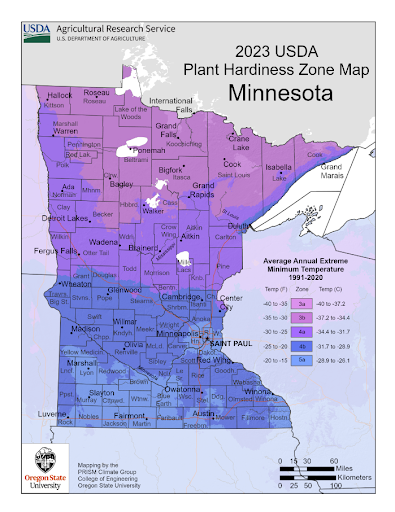
In November 2023, the US Department of Agriculture (USDA) issued an updated plant hardiness zone map — the first one since 2012. While some regions in Minnesota have remained the same as in the old map, there are many areas that have been bumped up a half zone. For example, Cambridge and Glenwood have been moved up from 4a to 4b, and Minneapolis, St Paul and Fairmont moved up from 4b to 5a.
The USDA hardiness zone map is a tool that helps growers determine which plants can survive the winter and thrive in a particular region. The zones are based on average annual extreme temperatures and represented by the numbers 1-13, separated from each other by 10° increments. The larger the number of the zone the warmer the average extreme temperature. (Hawaii is zone 12 and zone 13 is Puerto Rico.) Each zone is then further divided into two half zones, ‘a’ and ‘b’, with ‘a’ having average extreme winter temperatures 5° more than 13,000 weather stations gathered between 1990 and 2020. A group of horticultural, botanical and climate experts reviewed the data to produce the map. Because the 2023 map was created digitally through GIS technology, it allows for higher resolution and can show smaller areas of delineation, especially around cities, mountains and bodies of water. Cities have more heat-retaining amounts of concrete and blacktop so they can very often be assigned a warmer zone than the surrounding less developed areas. Thus the metro area of Minneapolis/St Paul has now been designated as Zone 5a, warming up from its former designation of Zone 4b. Most of the area surrounding the metro area has remained as zone 4b.
Plant hardiness zones do not guarantee plant survival, which is still influenced by soil type, light, moisture, space and management practices. It is also understood that warmer average temperatures can also allow more pests’ eggs and grubs to successfully overwinter. (For example it is believed that our mild winter temperatures this year will allow more Emerald Ash Borer and Japanese Beetle grubs to survive.) In addition plant species and cultivars all vary in zone hardiness. The Minnesota Department of Agriculture has determined the wine grape “Petite Pearl” to be hardy to zone 4 but the Concord grape is hardy only to zone 5 or greater.
So what does all this mean for us gardeners? There is not much of a shift in the zonal delineation in most of Minnesota, so we probably should not sway too much from what we would normally plant. But the ‘boost’ to zone 5a in the metro area means that some plants that were marginally hardy may have a better chance of surviving. It does not mean, however, that we can’t suffer much colder temperatures next year that may cause winter injury.
The changes in the hardiness zones should also not be confused with climate change. Zones are based on 30 years of extreme cold temperatures. Determination of climate change is based on 50 – 100 years of overall average temperatures. Plants experience weather and not climate. Some of the change in zones is because of additional data and improved interpolation methods. And some shifts actually resulted in cooler zones rather than warmer.
So, plant prudently. You may be able to successfully grow plants labeled zone 5, but it may all be dependent on the weather. If we experience more ‘normal’ winters in the future there is no guarantee that those plants will survive. But then again it is very tempting to try!


